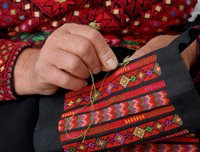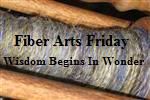Never could I sail, run marathons, quilt, ace chemistry exams or debate with confidence, but often I could do projects with my hands. And stitching embroidery was one of those feminine and housewifery activities that I learned at my mother's knee.
I was always proud of my samplers, praised for my dexterity in pulling embroidery floss up and through fabric to make a pretty chain stitch, then moving forward to work with silk ribbons in the 90's to create more intricate patterns on lingerie or sachet pouches. I still feel accomplished in creating pretty hand work with thread ends skillfully knotted and tightly tucked under on the back side of fabric, surely worthy of a prize if entered in the "Needlework" category in any county fair.
Yesterday, I picked up our local Senior Beacon, its target audience honed to those over fifty years of age. I was waiting for my eyes to dilate in the dimmed room provided by the ophthalmologist when I read various volunteer opportunities made available through the Beacon. Lo and behold, there in front of my now blurred vision was a blurb that embroiderers were needed at our local quilting shop for November 14, next Saturday. Embroiderers were requested to work on ribbons for Breast Cancer Survivors, among a few other causes. Proceeds from the sale of the ribbons would go back to their respective charities.
Carefully, I tore out that magazine notice with the published contact telephone number. Still waiting in the dimmed room, eyes becoming more blurred from the atropine drops used to dilate pupils, I could barely see the listed phone number. But why should I wait until later to call? When later came, I might decide to pass off the moment to share my handwork talent. They probably really needed me. With fierce bravado, I dialed on my mobile phone, was connected, then put on hold, then reconnected to the appropriate person designated to coordinate collective expertise of volunteers.
"Hello, my name is Nancy and I would like to volunteer a few hours next Saturday for the ribbon adornment embroidery work you are coordinating." This felt so satisfying. I was thinking of the finished ribbons and that maybe they might even sell for $5 each!
"We are so happy you called," the woman on the other end of the line responded, "and what hours can I put down for you?" she added.
"The afternoon would be best, maybe after 1:30," I said, reviewing in my mind that Julie and I could still have lunch together and that I could go from Mesa Manor and then home after putting in an hour or two on the ribbons. "And should I bring my materials with me? Will you provide patterns ?" I was mentally taking stock of what I would take: embroidery scissors, flossing threads, needles, my magnifying glass that hung on a cord, resting on the top of my bosom, intensifying the sight area where the needle embellishment was to be worked. I really needed both the magnifier and my bifocals to see well. Hmm, still thinking...
Coordinating Woman responded: "Oh, yes, please bring your threads. And what type machine do you have? What embroidery disks do you have? Do you have a letter font disk?"
What? What machine did I have? What disks? A font? "Oh." Ding, on went the light bulb. "I don't have a machine. I was talking about hand embroidery." Cringing inwardly, I realized she was talking about machine embroidery whereas I was referring to 18th century embroidery, the skill of which I was so proud.
Coordinating Woman: "Thanks anyway, dear," pause ..."that was nice of you to offer. Here we work with machine embroidery only."
It was then I realized that she must have thought my little crafting skill was anachronistic, certainly not of value in 2015. After all, their business sold expensive embroidery machines, along with every costly doohickey available. They were in business to make a profit, and they make good money keeping up with technology in embroidery.
Chagrined, I inwardly shrank, felt stupid and senior-ly old, out-of date, obsolete in not only my thinking, but also in my skill set. What a truly humbling, ego deflating experience.
“You will do foolish things, but do them with enthusiasm.” ― Colette
%2B%2BQuilting%2BBee%2B(1).jpg)

 This is a work shirt which I repurposed, using nine different pieces of vintage embroidery found on antique table runners and linen napkins to cover the front panels, back yoke and sleeve cuffs. Some of the embroidery was so old it was frayed, so using the Wonder Under product helped insure fabric stability.
This is a work shirt which I repurposed, using nine different pieces of vintage embroidery found on antique table runners and linen napkins to cover the front panels, back yoke and sleeve cuffs. Some of the embroidery was so old it was frayed, so using the Wonder Under product helped insure fabric stability. Incorporating vintage hankies on pillows top:
Incorporating vintage hankies on pillows top:  The fairie was sketched by Michelle at
The fairie was sketched by Michelle at 





























 More about Silk Ribbon Embroidery in next post.
More about Silk Ribbon Embroidery in next post.



 (front view of the pillow case above, and back view at upper right)
(front view of the pillow case above, and back view at upper right)





